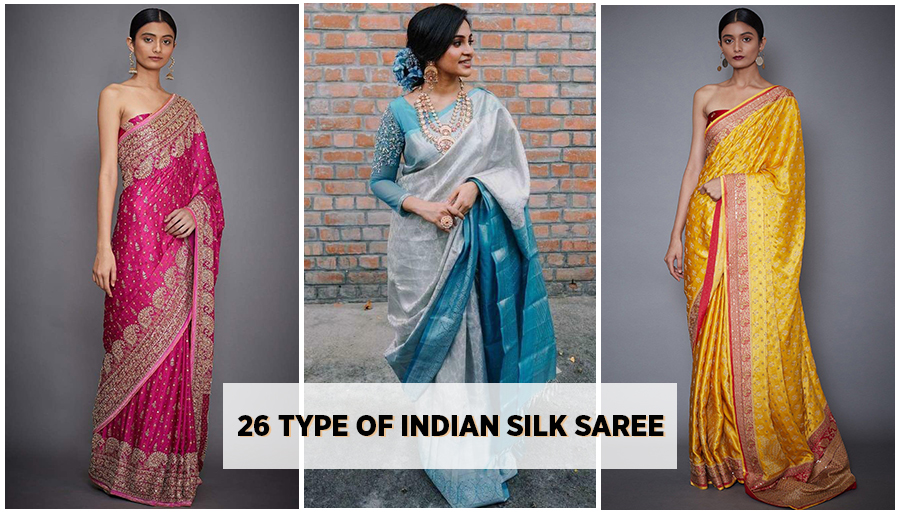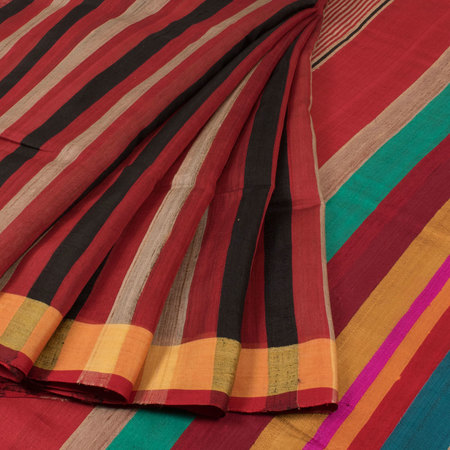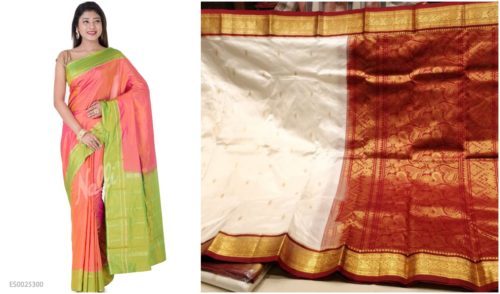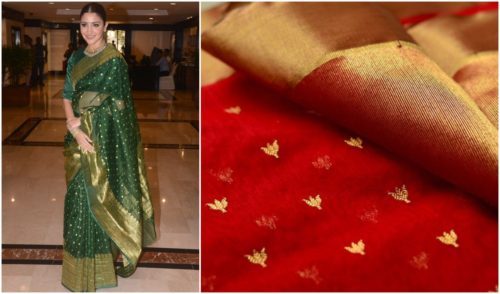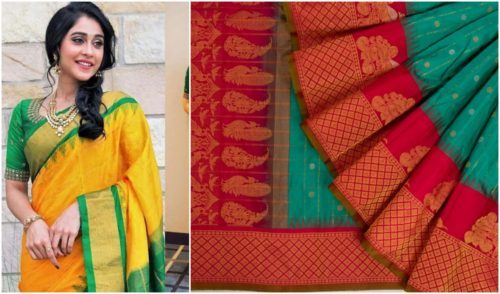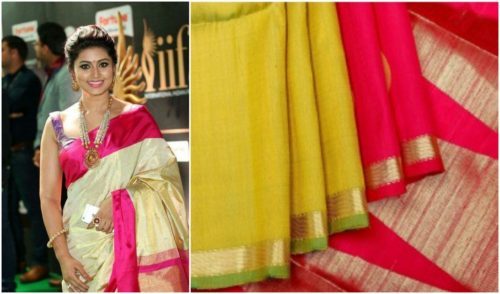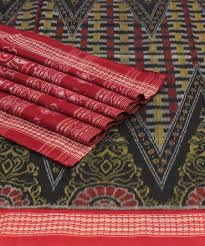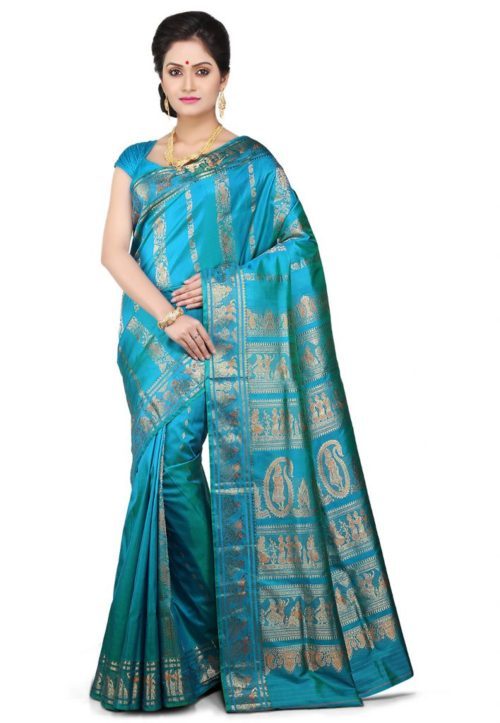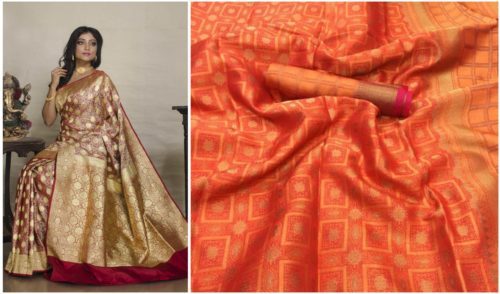Welcome to our blog all about beautiful silk sarees from India! We’ve got 26 different kinds to show you.
Each type of silk saree is like a special story. From the fancy Banarasi silk to the storytelling Baluchari silk, there’s so much to discover.
Whether you love sarees or are just starting to learn, we’re here to explore together.
Let’s dive into the pretty colors, cool designs, and the awesome traditions of each saree.
Types of Silk Saree From India
In this post, We bring 26 types of silk sarees from India, which are traditional and rich.
1. Assam Silk Sarees
Every woman has a dream to have one Silk Saree of Assam in their wardrobe because of its delicate and lightweight features.
Assam’s silk has been popular for ages. It comes in three types: golden Muga, white pat/part, and warm Eri silk.
The silk industry in Assam, mainly in Sualkuchi, relies on manual work. Traditional Assam Silk Saree is made by hand-weaving.
Moreover, It takes more than a month to complete. Assam Silk Saree price range is not much expensive as patola and Kanjivaram silk saree.
Price Range – INR 5000 onwards
Types of Assam Silk Sarees
I. Assam Silk Muga/Mooga Silk Saree
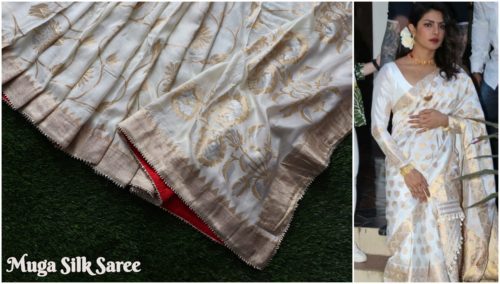
The Muga Silk Saree is produced from the Antheraea assamensis silkworm feed aromatic plant in Assam, this silkworm produced lustrous glossy golden tint silk. Also, Its luster increases after every wash. In this, Muga silk is firstly dyed then bleached. Muga silk is now weaved into beautiful, intricately designed, traditional Assamese wear for ladies (mekhela chadar).
II. Assam Pat/Paat Silk Saree
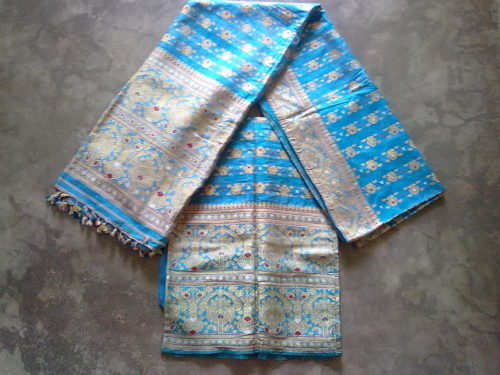
Pat silk is produced by Bombyx texter silkworms found on mulberry leaves. Usually, It is in brilliant white or off-white color. It is lightweight and delicate in texture, it has good durability.
Also, Saree is woven into bright colors traditional motifs, which include flowers, human figures, animals, etc, around the border. Moreover, It perfectly compliments the Assamese bride.
III. Eri Silk Saree Assam
Eri silk is produced from ailanthus silkmoth which feeds on the leaves of the castor oil plant. In addition, It is popular as non-violent silk, also often known as the ‘poor man’s silk. This silk has a rough texture and is less lustrous than the other two silk saree of Assam.
2. Art Silk Sarees
Artificial silk or art silk is produced from synthetic fiber which resembles silk, It is also sometimes known as bamboo silk. Artificial silk is just a synonym for the Rayon. Normally the Art Silk Sarees price is less to other types of Silk Sarees.
The first artificial silks were produced in the 1890s from cellulose fiber and were popular in the market as art silk or viscose. Artificial silk is nylon, polyester, rayon, etc. Below is the image for more clarification.
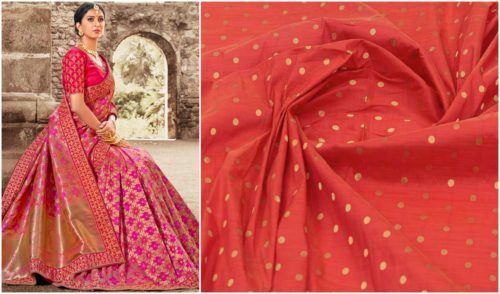
Art Silk became a prominent industrial fiber in a short time frame, permanently replacing silk in many fields. Due to it, the latest art silk designer sarees buy easily by all groups of people.
It is more slippery compared to other types of silk sarees, although it is distinguishable from pure silk. If you want to distinguish both, rub the pile in the hand, burn a small piece of the fringe to smell the ash or smoke or dissolve the pile by performing a chemical test.
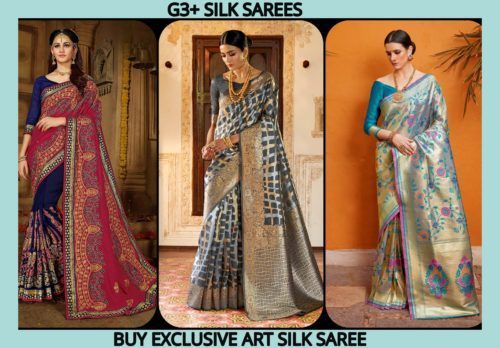
Hand-wove art silk saree is not possible, It is always manufactured in the machine. You can easily get Art Silk Sarees Online nowadays, also it is available at a low price which starts from Rs 1000. Furthermore, You can click the above image to see Art Silk Saree’s new arrival or Art silk sarees with price.
3. Banarasi Silk Saree
It is a symbol of richness and classiness. It is often part of an Indian bride’s. Also, the Banarasi silk saree features are gold work, compact weaving, figures with small details, metallic visual effects, pallus, jal, and mina work.
Banarasi Silk Sarees from Varanasi has a great demand for Indian Weddings. It is derived from Varanasi city, which is also called Benares or Banaras. Besides, Pure elegance Banarasi silk saree is enough to take place in the heart of the bride.
The traditional Banarasi sarees are constructed, with a lot of hard work and skillful work by using silk and gold and silver brocade or zari.
In addition, Banarasi silk sarees handwoven and intricate with interweaving floral and foliate motifs, kalga and bel, a string of upright leaves called jhallar at the outer edge.
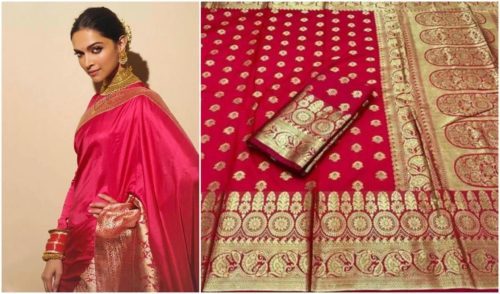
Also, It takes 15 days to a month and sometimes up to six months to complete, depending upon the Banarasi silk saree design. Furthermore, Its main four varieties, which include pure silk (Katan), Organza (Kora) with Zari and silk, Georgette, and Shattir, and according to Banarasi silk saree design process, they are divided into, Jangla, Tanchoi, Vaskat, Cutwork, Tissue, and Butidar. Banarasi Silk Saree Price/Cost normally starts from Rs 20,000 to the Banarasi Silk Saree bridal collection Rs.2,00,000.
You can buy the latest Banarasi Silk Saree Online,
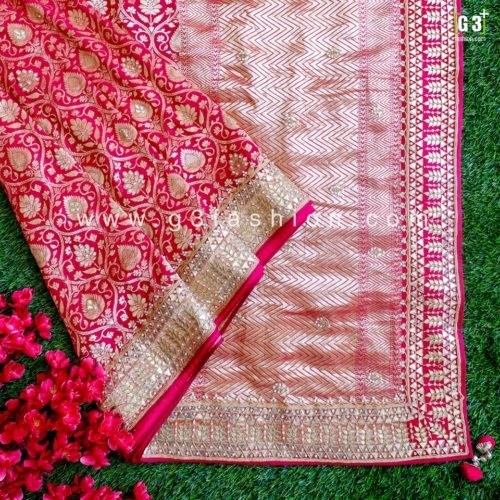
4. Baluchari Silk Sarees
Baluchari Silk Sari origin from a small village called Baluchar in Murshidabad district, Bengal but presently Bishnupur. The Baluchari silk sari was one of the award winners for the main weaving styles amongst 34 National Awards for the years 2009 and 2010.
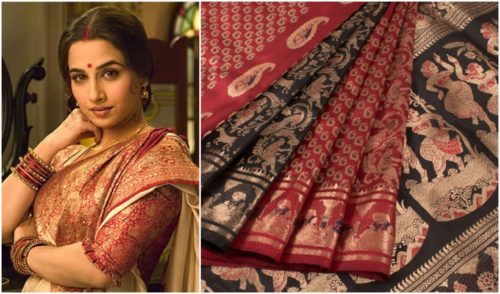
Baluchari Silk Saree design is known for the mythological scenes on the pallu of saree. Today we frequently saw the scene of Mahabharat and Ramayana. It takes approximately one week to complete one such saree.
During the time of Nawabs and Britisher’s eras, pallu comes in the square design of paisley motifs design, scene of lives of the Nawab of Bengal featuring women smoking hookahs, nawabs in horse carriages, and even European officers of the East India Company.
The saree is made from the cocoon of the silkworm.
The beauty of the Baluchari Silk Saree is, it is polished after weaving. The Baluchari Silk Saree price/cost range starts from Rs 20,000 to Rs 2,00,000. Click to shop Baluchari Silk Saree online.
5. Bomkai Silk Sarees
Bomkai Silk Sarees are derived from the Bomkai, Ganjam district of Odisha or Orissa. It is also known as Sonepuri Sari. This handloom silk sarees are a popular item, appear in various fashion shows.
In past days Bomkai silk sarees of Orissa design in captivating colors with fish motifs weave are seen in the sari, as it is believed to be a sign of success and affluence.
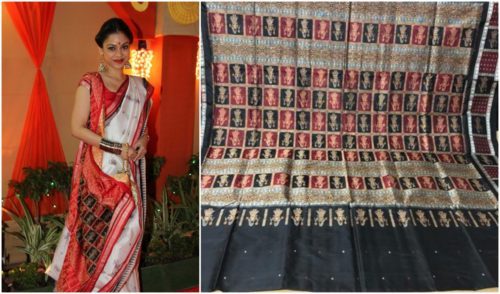
Now it is available in modern design with a Traditional Tinge at the border and pallu section. You can see above Bomkai Silk Sarees images for more clarification of design.
Bomkai Silk Saree Cost / Price range start from Rs 10,000 – 50,000. Ashwariya Rai Bachhan wore a kind of bomkai called “Radhakunja” during her wedding day, designed by the Chaturbhuj Meher at Sonepur.
6. Bhagalpuri / Tussar Silk Saree
It comes into existence, during the Industrial Revolution and it is much cheaper than silk. Due to its cooler nature, this silk is more wearable in hotter parts of the earth.
Tussar Silk Saree is another name for Bhagalpuri Silk Saree. Kosa is the Sanskrit name of Tussar silk. Tussar silk saree origin from Bhagalpur and it is more than a century old.
It is more popular in tribes. Its silk is produced from the larvae of several species of silkworms belonging to the moth genus Antheraea.
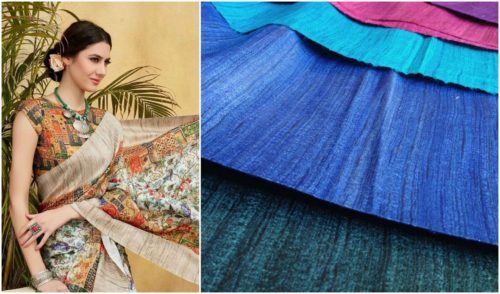
Tussar silk saree design is famous for its rich texture and natural deep gold color with radiant work of nature-inspired motifs easily make different from all.
Designers like Sabyasachi and Manish Malhotra have always experimented with this fabric. Tussar Silk Saree Price/ Cost start from Rs. 2500 onwards.
Its main feature is, it reflects two different shades at different angles. At present Tussar Silk Saree Collection is mainly produced at Jharkhand in India.
7. Banglori Silk Sarees
Banglori silk sarees are known for their simplicity and purity of silk appearance. The first silk is produced in Basavanagudi, in the southern part of Bangalore, Karnataka. In past, only dark hues silk saris with gold threads woven at the pallus were in trend, however, the latest Banglori silk saree available in double-color, printed crepe silk saris, reversible silk saree design, Banglori silk printed saree is more popular in young ladies. Banglori silk saree price range starts from Rs 10000 onwards.
8. Chanderi Silk Saree
The best feature of the handwoven chanderi silk saree is, its lightweight, shinning, smooth, soft, and transparent sheer texture, and the unique motifs inspired by nature, make women fall in love with it.
Chanderi Silk Saree Information
Chanderi silk sarees are the origin of Chanderi and it’s one of the finest types of silk sarees of Madhya Pradesh. Its production is at its peak in the Mughal era. It is categorized into three types i.e silk cotton, pure silk, and chanderi cotton. Chanderi Silk Saree’s design includes traditional coins, floral art, peacocks, and geometric designs.
It is popular for its gold and silver brocade or zari, fine silk, and opulent embroidery. Chanderi Silk Saree’s price starts from Rs (3500). See above Chanderi Silk Saree images for more clarification.
9. Dharmavaram Silk Sarees
Dharmavaram Silk Saree is derived from Anantapur district, Andhra Pradesh. This saree is majorly referred to as a bride saree in the South Zone of India. Dharmavaram silk set its roots in the world of tradition not because of adding more magnification into ethnic fashion. Also, These types of silk sarees can suit on any age group and any types of body shapes.
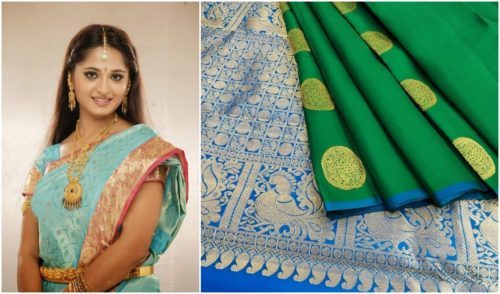
Dharamvaram saris are well known for the gold-plated borders and artwork print on them. Besides this fabric also includes gold brocaded patterns and motifs like elephant designs, peacocks, or even the aesthetic temple borders, which shows the religious culture through these saris. The dharmavaram silk sarees price range from INR 10000 – 1,50,000.
10. Gadwal Silk Sarees
Gadwal Silk Sarees origin of Gadwal in Andhra Pradesh. It is famous for its alluring mixture of fabric and designs. The uniqueness of this saree is, the whole saree is in the cotton fabric while the border is in silk.
Traditional Gadwal Silk Saree techniques were used to design gadwal silk saree collection known as Kupadam and the weaving style for the borders was known as kumbam. Currently, this types of silk sarees are interwoven with the weft technique.
The Gadwal Silk Saree weaver was weaving this saree in pure Silk as well and available in contrasting colors like lime green or a canary yellow. The charm of the saree is that you can fold it to the size of a matchbox. Gadwal Silk Saree’s price range starts from RS 30000.
11. Kanjivaram Silk Saree / Kanchipuram Silk Saree
Kanjivaram Silk Saree is considered as a royal, heritage, and wealthy saree among all types silk sarees. It is mostly preferred by the bridal of south India for a special occasion. Kangna Ranaut opted for a golden Kanjiwaram silk saree at Cannes 2019. Its lustrous silk fabric is weave is its USP of these sarees.
Kanjeevarum saree is also known as Kanchipuram silk saree, the origin of the Kanchipuram region in Tamil Nadu. It is weaved from pure mulberry silk of Kanchipuram and zari from Gujarat. It is weaved in 3 shuttles. Traditional kanjivaram silk saree distinguishes with its contrast border, temple borders, checks, stripes, and floral motifs. The cost of depending upon the Kanjivaram Silk Saree design, color, pattern, and quality of silk & zari used.
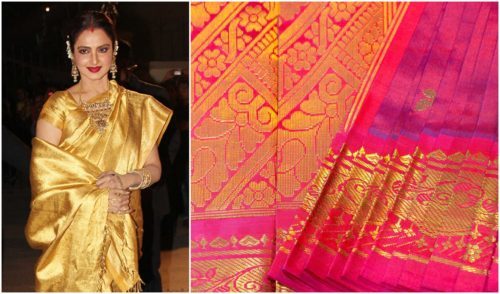
As per the legends, it is believed that this silk was considered to be Lord Shiva’s and Lord Vishnu’s favorite fabric. Its Durability and shiny made this saree popular all over the world, especially in the south zone of Indian weddings, festive and occasions.
In the traditional Kanchipuram Silk Saree, the body and border are weaved separately and then interlocked together with a zig-zag line. The Kanjivaram Silk Saree price starts from Rs.15,000 to the Kanjivaram silk bridal saree collection Rs.5,00,000. Below are the Kanjivaram silk saree images by Bollywood diva Rekha carry successfully.
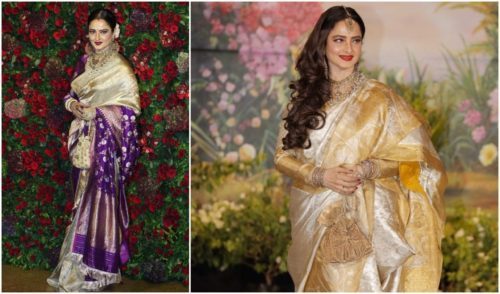
12. Konrad Silk Sarees
Konrad silk sarees are one of the most well-known South Indian sarees origin of Tamil Nadu. It is characterized by the border, embellished with different designs. The borders range from 10-14cm wide and are weaved in plain color with narrow bands of supplementary warp patterning. It is quite popular as temple sarees too at some of the parts.
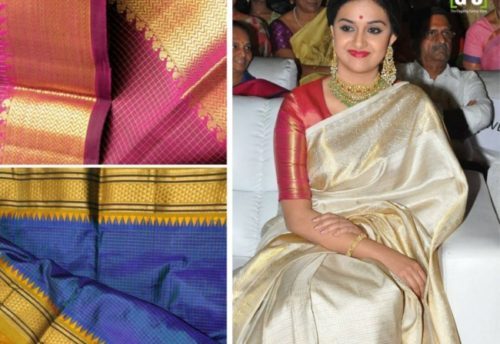
These sarees are different from other silk by their wide borders that are exclusively intricate with designs or motifs of natural elements, motifs like flowers, vines, creepers, besides animals and birds motifs such as peacocks, elephants, parrots, double-headed eagles, etc. Konrad Silk Saree’s price range starts from Rs 7000. Konrad silks are not as heavy as other silk sarees, though it is very much lustrous from others.
13. Kota Silk Saree
These Sarees are very light weighted and easy to handle. It is also popular as known as ‘Kota-Masuria’ from the 17th and early 18th centuries. Except for sarees, this fabric is used in Salwar Kameez, Lehengas, and Home furnishings items. It is derived from kaithun in Kota, Rajasthan.
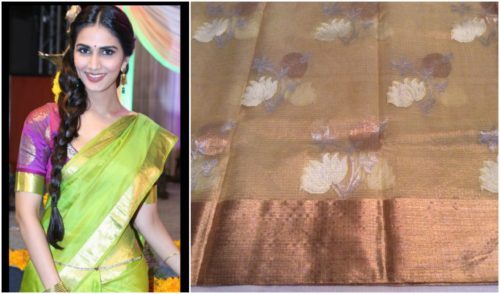
Kota Doria or Kota Doria is made of pure cotton and silk and weaved in square checks patterns known as chowkdi. They smudge onion juice and rice paste with a lot of care into the yarn making the yarn so strong that no additional finishing is required for preparation. The Kota Silk Saree price range starts from Rs 4000.
14. Korial Silk Saree
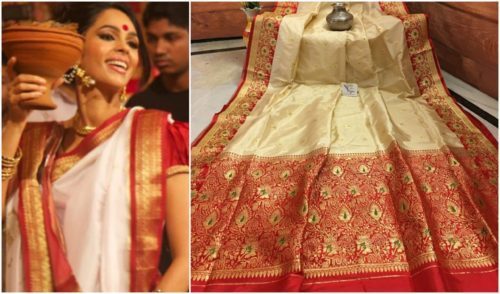
Traditional Korial Saree wears by Bengali women in poojas, festive and other occasions. Korial sarees are produced in the Murshidabad district of West Bengal. Its texture is similar to tissue, also it is light in weight and easy to drape and handle. The word korial means solid or blank.
Garad silk saree is identical to Korial saree, except for the border which is more intense in design and rich red hue. Korial Banarasi Silk saree is quite a favorite among ladies because of its dual characteristic, it is in lavish white base saree having border gold or silver zari embellishments as Banarasi sari.
Most often time this sari becomes a choice of aged ladies at weddings. Korial Silk Saree Price Range starts from INR 1500 onward.
15. Mysore Silk Sarees
It is mostly worn during Indian festivals or weddings by ladies, it is more of an occasion-oriented fabric. Mysore silk saree has a royal vibe that suits ceremonial occasions. Brides of Karnataka first prefer a Mysore silk saree for the wedding day.
The Mysore silk comes from the city of Mysore, Karnataka. It’s manufactured from pure silk with gold Zari. Inspired by the natural ambiance and customs of the time, the Mysore silk sari continues to preserve the heritage of India.
The demand for a Mysore Silk saree is unbeatable not only in India but also abroad. It is considered to be the purest form of silk, its silk is so soft buttery silk also Mysore silk saree collection is very light and beautiful with not much bling.
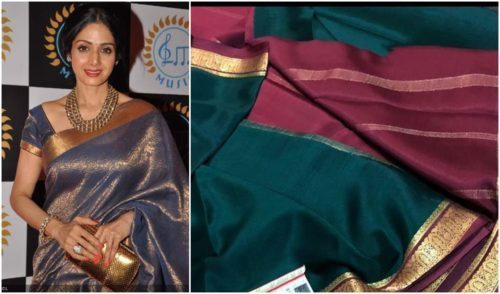
It is popular because of its durability and its long-lasting luster. Mysore silk is produced from mulberry silk and it is the highest quality of silk from the cocoons.
The Mysore Silk Saree Price range starts from Rs.6000 to Rs.20,000. Nowadays t is available in more color and variety. Its print is gaining popularity around the globe.
16. Matka Type of Silk Sarees
This rough handwoven matka silk fabric is crafted from waste Mulberry Silk, specifically Bombyx Mori, without removing its sericin part. Its primary production occurs in Karnataka and Kashmir, while the spinning process takes place in the Malda and Murshidabad districts of West Bengal.
Matka Silk originates from thick yarn spun by the silkworm Bombyx Mori, resulting in a textured roughness akin to tweed fabric.
Renowned Bollywood actresses like Vidya Balan, Kiron Kher, and Tisca Chopra have adorned these silk sarees at various events. Matka Silk Sarees are priced lower than other silk sarees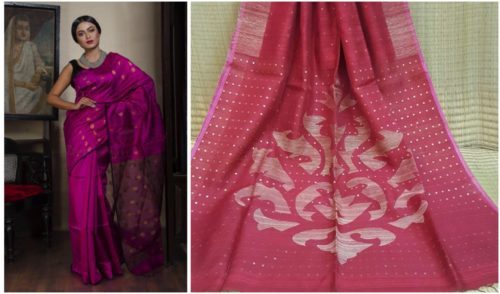
17. Narayanpet Silk Sarees
Narayanpet silk sarees feature a distinct style, showcasing checkered designs with embroidery, while the border or pallu intricately display ethnic temple designs.
The contrast look with small zari weaves in borders and pallu of the Narayanpet Silk Sari. It takes 4 – 5 days to be complete.
The style of weaving shows the distinct influence of two states, i.e. Maharashtra and Telangana because weaves migrated from the Maratha region to Narayanpet.
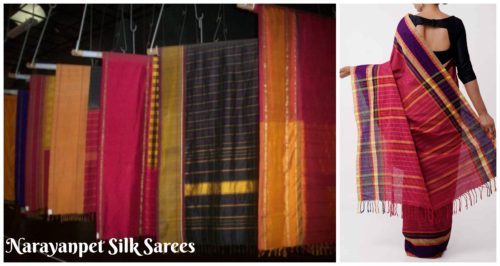
These sarees have enjoyed the royal patronage of the Marathas. Artisans weave the pure Narayanpet silk saree in dark earthy shades.
Usually meant for daily wear, these sarees do not feature any motifs.
The unique process involves weaving eight sarees simultaneously on a loom, unlike the standard practice of weaving 7 yards of fabric. Narayanpet Silk Sarees price starts from Rs. 1000 to Rs. 6000.
18. Organza Silk Saree
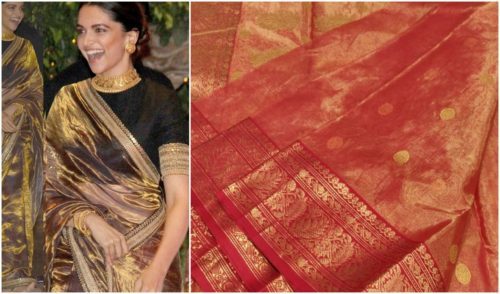
19. Patola Silk Saree
Patola is a plural form, the singular is patolu, it is the origin of Patan, Gujarat. These handloom patola silk sarees are very expensive, afford by only those who are belonging to royal and aristocratic families.
It’s a silk saree with a double ikat weave. It takes 6 months to 1 year to complete one sari, due to its long process of dying each thread separately before weaving them together.
Patola Silk Saree design weave with motifs and patterns inspired by animals and other elements of nature. Normally Patan Handloom Patola Silk Saree Price range starts from Rs 1,00,000 to Rs 7,00,000.
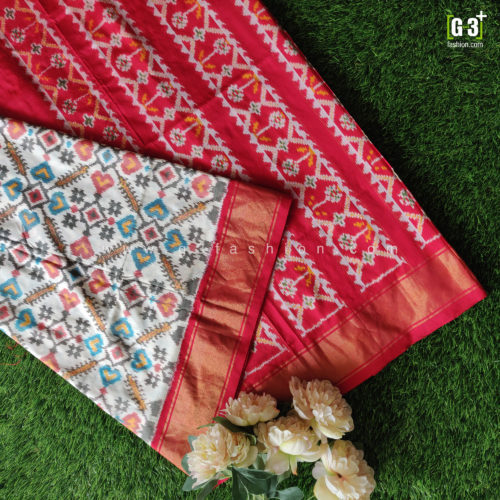
There are four different patterns that patola weave primarily by the Salvi community. In Hindu communities, saris with designs consist of parrots, flowers, elephants, and dancing figures use.
Muslim populations wear saris with geometric designs and floral patterns, while Maharashtrian Brahmins wear saris woven with simple, dark color borders and bodies, along with a bird motif known as Nari Kunj. At present, there are semi weaves of Patola sari that are available in an affordable range of INR 15,000 onward.
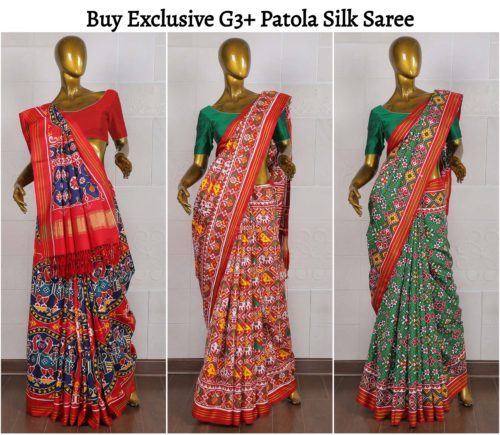
20 Paithani Silk Saree
This saree reveals the richness of Maharashtra, as artisans craft it from very fine silk. It becomes the first choice of a bride for her wedding day.
Paithani takes its name from the town of Paithan in Aurangabad, Maharashtra. Artisans create handloom paithani silk sarees from real silver or gold and very pure silk, making them one of the most expensive silk saris.
The uniqueness which brings Paithani Silk Saree design different from other silk sarees by oblique square design made on borders, and a pallu with a vibrant color of weave design such as Peacock, flower, birds, and the art from Ajanta Ellora caves. In the olden days saree weave in cotton yarn then later on in the 19th-century weave in silk.
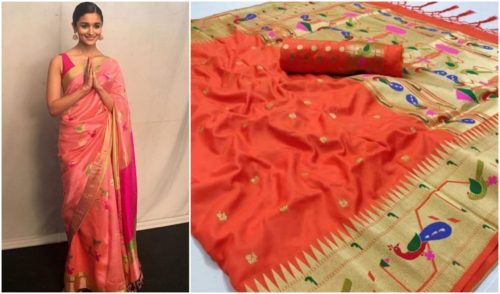
Paithani Saree is classified into three categories i.e motif, weaving & color also it comes in bright shades like magenta, dark green, purple, peacock blue, etc.
Pure Paithani silk saree price range starts from sixty thousand to five lakh rupees and Semi Paithani silk sarees price starts from Rs 25000 onward.
21. Pochampally Silk Saree
Pochampally Silk Saree is the origin of the town of Boodhan Pochampally, located in the Nalgonda district of Andhra Pradesh. The town is popular as the silk city of India, these sarees are culturally popular for the Ikat weave and designs imprinted on this fabric.
It is a blend of the essence of cotton and silk together by weaving them together.
Weavers weave these Ikat patterns into the cloth in geometrical forms, ensuring that the entire appearance captures the attention of both the wearer and onlookers.
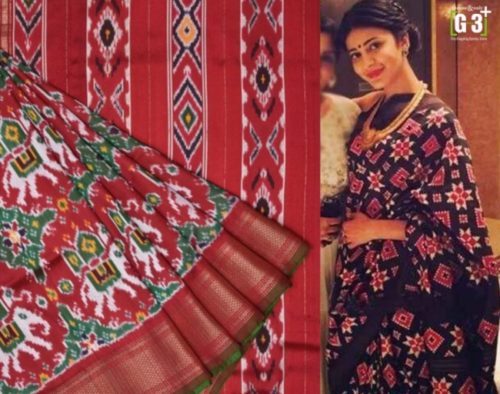
The South Indian brides prefer pochampally types of silk saree for wedding ceremonies. Its ikat weave resembles patola weave.
The weave motifs of a Pochampally saree have more traditional motifs like elephants, peacocks and floral and also include geometric and zigzag designs in it. Pochampally silk saree price range starts from 10,000 Rs onward.
22. Raw Silk Saree
In different parts of India, raw silk, known as ‘Paat,’ ‘Resham,’ and ‘Pattu,’ is the most natural type of fine fiber that weavers can easily and smoothly weave into various textiles.
These made from mulberry tree silk made yarns in short and damaged yarns, bound together in a spun thread. These also have lustrous sight and a soft feel with a textured effect due to the short yarns made into the fabric. 7000 onward
23. Sambalpuri Silk Saree
- The feature which makes it unique from all is its weaving process ‘Bandhakala’ (ikat process), in this process, the threads are first tie-dyed and then weave into a fabric, the entire process taking many weeks to complete.
- It is mainly in red black and white color which represents the Odisha tradition. Usually, The Sambalpuri silk saree price starts from Rs. 10000 to Rs. 1,00,000.
- Sambalpuri sari includes four varieties – Sonepuri, Pasapali, Bomkai, Barpali, and Bapta saris, which are in high demand.
24. Sournachuri Silk Saree
Artisans usually draw inspiration from Indian mythological stories like the Ramayana and Mahabharatha for the designs and patterns on the sarees. Some of these sarees can represent an entire story of the Bhagavad Gita. Furthermore, Sournachuri types of Silk Sarees refers to the sister of Baluchari silk saree, and it comes from West Bengal.
The borders of the sarees are very ornamental with Kalka motifs and classic Bengali motifs of animals, flowers, circles, and fish are intricate. Normally, it is available in dark colors. It takes a week to weave a single saree.
Price Range: INR 25000 onward.
25. Tanchoi Silk Saree
Tanchoi is the weaving process, where a single or double warp and two to five colors on the weft are of the same shade weave with Silk fabric. In addition, These types of silk sarees are intricate with small weaving patterns over the fabric, general patterns of flowers, small birds in flight, peacocks, and parrot motifs. Also, The fabric texture of tanchoi is the same as the satin fabric. Ultimately, It is perfect for formal occasions, wedding ceremonies, or festivals.
Moreover, The credit of innovation of tanchoi is going to the weavers of Banaras. They brought zari into the already complex weave of art. Also, Banarasi Tanchoi has several different varieties are Satin Tanchoi, Satin Jari Tanchoi, Atlas, or Gilt, Mushabbar.
Price Range: INR 35000 onward.
26. Uppada Silk Saree
The Uppada Silk Saree gets its name from a small beach in Andhra Pradesh’s East Godavari district. Crafted using the traditional Jamdani method, it boasts a unique making process. Additionally, artisans measure the thread count of these sarees in both length and width.
Also, The weaver uses a lot of zari work in the graceful designs of Uppada Silk sarees.
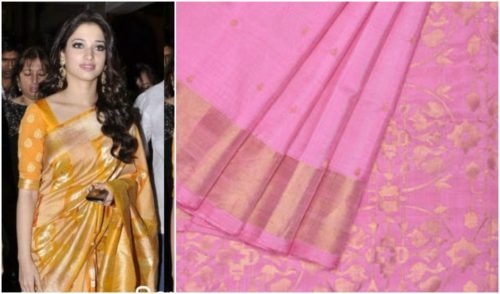
Uppada types of silk sarees weaving process takes approx 10 – 60 days. In this, at least 2-3 weavers have to spend 10 hours of their day. They use pure silver zari lace dip in melted gold and fine silk to weave.
Most Uppada Silk Sarees feature common patterns like geometric shapes, flowers, and leaves. You can easily fold and store these sarees in a box. The price of Uppada Silk Sarees ranges from five thousand rupees to twenty thousand rupees.
These types of silk sarees are evergreen and many generations can style it in their own way.

